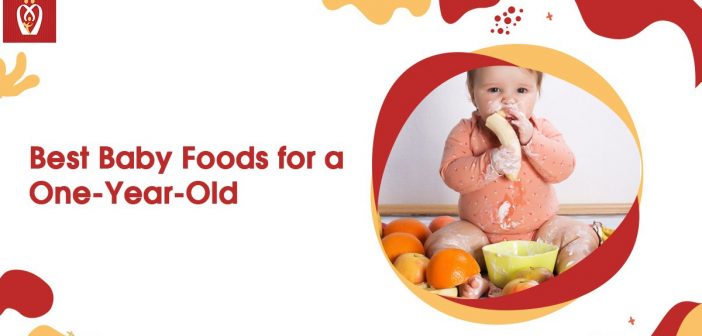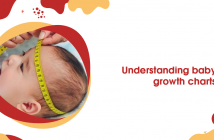Your one-year-old is developing, growing, and learning at a breakneck speed. So, it’s understandable that ensuring they obtain the best baby foods is a worry.
Inconsistency in meal choices and a fickle appetite are expected at this age. This is very typical as your toddler gains independence and learns to recognise their body’s fullness and hunger cues .
Toddlers require roughly 1,000 calories, 700 mg of calcium, 600 IU of vitamin D, and 7 mg of iron per day by the time they reach the age of 12 months.
With so much going on, you may be wondering how to feed your one-year-old without spending the entire day in the kitchen or chasing them about.
Here are the best baby foods that are both healthy and practical for one-year-olds.
Soft fruits such as bananas, peaches, and other tropical fruits
As they attempt to self-feed, your 1-year-old begins to develop their pincer grasp, which involves pinching and manoeuvring food with their fingertips. This is an excellent time to introduce finger foods.
Fresher, softer fruits are one of the Best Baby Foods for this changeover period and beyond. They are also one of the most nutritious foods and have a variety of beneficial plant compounds, but they also aid in the formation of good eating habits.
Slice bananas, clementine’s, strawberries, peaches, or mango into little pieces and gradually introduce them to your child. Large bits of fruit should be avoided because they may cause discomfort and even choking.Avoid giving your child whole grapes; cut them into halves or quarters.
Don’t worry if your child doesn’t like the new fruit right away. According to studies, a youngster must be introduced to a fresh meal 6–15 times before accepting it into their diet.
Soft, fresh fruits can also be easily blended into a smoothie or eaten as a snack on the go hence making it one of the best baby foods.
According to the Centres for Disease Control and Prevention, make sure your child eats any cut-up fruit within 2 hours of taking it out of the fridge. If you’re outside and the temperature is beyond 90°F (32°C), that time will be cut in half.
Milk and yoghurt
It’s an excellent time to introduce cow’s milk if your child is slowly weaning off breast milk or formula.
Milk and yoghurt are high in protein and calcium, both of which are beneficial to their developing teeth. One glass (244 mL) of whole milk provides 39 per cent of your 1-year-daily old’s calcium requirements, as well as 8 grams of protein.
While breast milk can be given until the child is two years old or more extended, whole fat dairy milk or yoghurt can be given at mealtimes or as a snack. Yoghurt can be served with fresh fruit chopped on top or drizzled with honey.
Honey can be offered at this age, but never feed a child under 12 months. This puts children in danger of contracting botulism, a potentially fatal infection hence it has gained its spot as one of the best baby foods.
While dairy usually is acceptable at this age, keep an eye out for symptoms of a casein allergy.
Casein is a milk protein. It’s not to be confused with lactose, a sugar contained in milk that many adults have trouble digesting.
Casein allergy affects roughly 2–3% of children under the age of three, but more than 80% of them outgrow it. It appears most common in infants exposed to cow’s milk when nursing was impossible.
Make sure to introduce the most nutritious foods to your youngster, including milk and dairy products. It’s best to introduce one new item at a time and wait 3–5 days before adding another to see how their body reacts.
Wheezing, hives, vomiting, and diarrhoea are all symptoms of casein allergy. Stop feeding your child this meal and speak to their healthcare practitioner if they have these or other reactions when introducing them to a new food.
Also, before giving your child plant-based milk replacements, consult with their paediatrician, as these are generally not suggested for toddlers due to their lack of key nutrients for growth.
A bowl of oatmeal
Children don’t master the jaw-grinding motion, which aids proper chewing until they are four. Meanwhile, their meals must be mashed or cut into small, chewable bits.
Oatmeal is one of the best baby foods for your child when they learn to chew. It’s simple to consume and has a unique nutritional profile, including substantial protein, carbohydrates, vitamins, minerals, and good fats.
Furthermore, oats are high in fibre, which aids in the health and regularity of their digestive tracts.
While pre-mixed products are tempting, make your blend if you want to minimise kids’ sugar intake. If you’re short on time, try preparing overnight oats by simply soaking them overnight in the fridge.
If you mix your oats with milk instead of water, your child’s bowl will have more nutrients. Serve with chopped strawberries, bananas, or your child’s favourite raw fruit as a garnish.
Pancakes made with whole grains.
Pancakes are a favourite breakfast item among children, and whole grains are high in vitamins, minerals, and fibre making it one of the best baby foods. As a result, whole-grain pancakes are a perfect choice for feeding your one-year-old.
Gut-friendly prebiotics found in whole grain pancakes aid in feeding good gut bacteria. They’re also finger-friendly when sliced into bite-sized pieces.
Make them yourself or buy a 100% whole grain mix. Top with freshly sliced soft fruits, applesauce, or a drizzle of honey after sizzling them on a skillet or griddle.
Apply a very thin layer of creamy nut butter on top to add even more protein. However, because tree nuts are a common allergy, they gradually introduce them into their diet.
Eggs
Eggs are a nutritional powerhouse for both children and adults.
They’re high in protein, healthy fats, and other nutrients that promote eye health and optimal brain development.
Serve them scrambled or hard-boiled and peeled. If your toddler is attempting to self-feed, make sure to cut any of these into bite-sized pieces.
It’s worth noting that eggs are among the top eight allergen-causing foods for kids. Most children outgrow the allergy, but symptoms such as hives, nasal congestion, stomach difficulties, coughing, wheezing, and shortness of breath should be monitored.
Eggs can trigger anaphylaxis, a life-threatening allergic reaction that causes airway constriction, light-headedness, and loss of consciousness. If you have concerns about an egg allergy, consult a physician.
A lot is going on with your one-year-old. Among other developmental milestones, they’re experimenting with self-feeding, learning to recognise hunger and fullness, and establishing their independence. Fresh, soft fruits, steaming vegetables, tofu, and eggs are all practical and healthful dietary choices as you navigate this period of development and change. The goal is to choose the most nutritious foods that are simple to chew, soft
Don’t worry if they have a fickle appetite or if their food preferences change with the wind; it’s all part of the process.
Using Nurturey’s intuitive tools, you will be able to make sure that your child gets the best start in life. You can monitor your child’s growth and development with growth charts, Z scores, and BMI, as well as receive health insights directly from the NHS. Download our app now







